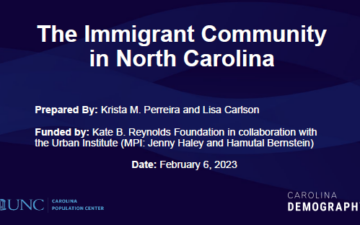Last year, our partners at the North Carolina Department of Public Instruction (NCDPI) approached us about a project to develop a North Carolina School District Typology. During the fall of last year and this past winter we developed the typology and solicited feedback from superintendents across the state via two webinars hosted by NCDPI. This past spring, we completed the typology and were honored to present our findings to the North Carolina State Board of Education’s meeting in Haywood County (2:50 mark). In this blog, we discuss the 2025 North Carolina School District Typology and provide an interactive map for you to explore the data used to group similar school districts and see which school districts are most like yours.
WHY DO WE NEED A SCHOOL DISTRICT TYPOLOGY?
We need a reliable and comprehensive way to group school districts in North Carolina for research and evaluation. It is hard to compare districts because there are many differences in local areas across the state’s 115 school districts. In the past, people often grouped districts by county population density. That helps, but it does not account for everything. First, some counties have more than one school district. Population density by county does not show differences between those districts. Second, districts with similar population densities may still have very different social, demographic, and economic contexts.
Because of those issues, NCDPI teamed up with Carolina Demography to develop a typology for all 115 school districts. This typology uses social, demographic, and economic data. It will help NCDPI and educational stakeholders across the state compare NC school districts more accurately for purposes of research, evaluation, and scaling interventions. This effort was inspired by the 2013 School District Typology created by the Ohio Department of Education.
HOW DID WE DEVELOP THE TYPOLOGY?
Our typology uses the following district level factors:
We used a statistical method called Ward’s linkage, a hierarchical clustering algorithm, to divide the 115 school districts into 10 groups. This method keeps districts in each group as similar as possible by considering the distribution of all of the factors listed above. You can access the the full methodological report at the link below:
LIMITATIONS AND STRENGTHS
Because the algorithm includes ten distinct factors, districts in the same group will still have some differences. This typology does not claim to put districts into perfect categories by socioeconomic, demographic, or institutional conditions. Nevertheless, it places districts into ten groups where districts in the same group are more alike overall than those in different groups.
INTENDED USE AND NEXT STEPS
The 2025 North Carolina School District typology is intended to be a useful tool to help educational leaders, researchers, and other stakeholders make more appropriate comparisons across the state’s 115 school districts.
Moving forward, we are excited to continue partnering with NCDPI and The Collaboratory at UNC-Chapel Hill to build on this momentum and develop a school-level typology – forthcoming in 2026!
Need help understanding population change and its impacts on your community or business? Carolina Demography offers demographic research tailored to your needs.
Contact us today for a free initial consultation.
Contact UsCategories: Education

The Center for Women’s Health Research (CWHR) at the University of North Carolina School of Medicine released the 12th edition of our North Carolina Women’s Health Report Card on May 9, 2022. This document is a progress report on the…

Dr. Krista Perreira is a health economist who studies disparities in health, education, and economic well-being. In collaboration with the Urban Institute, she recently co-led a study funded by the Kate B. Reynolds Foundation to study barriers to access to…

Our material helped the NC Local News Lab Fund better understand and then prioritize their funding to better serve existing and future grant recipients in North Carolina. The North Carolina Local News Lab Fund was established in 2017 to strengthen…
Your support is critical to our mission of measuring, understanding, and predicting population change and its impact. Donate to Carolina Demography today.